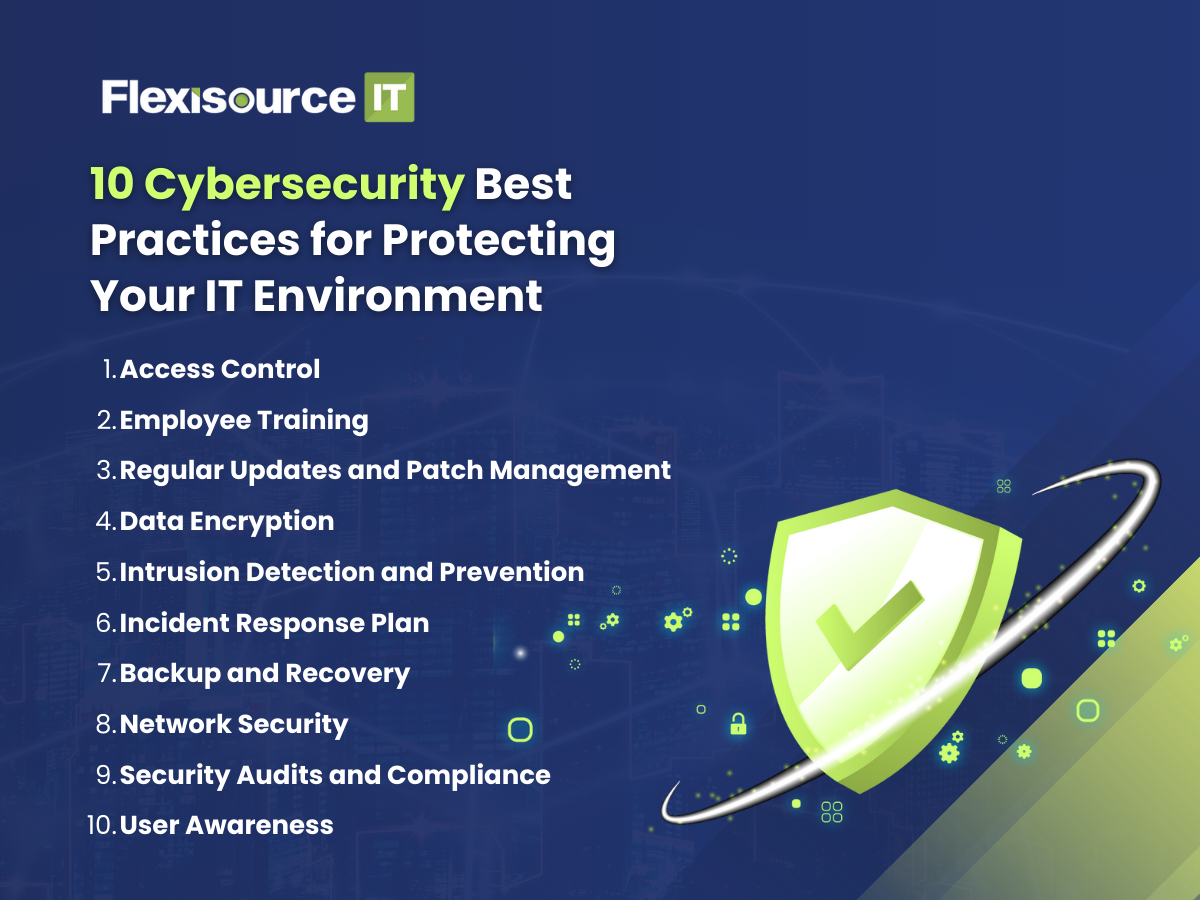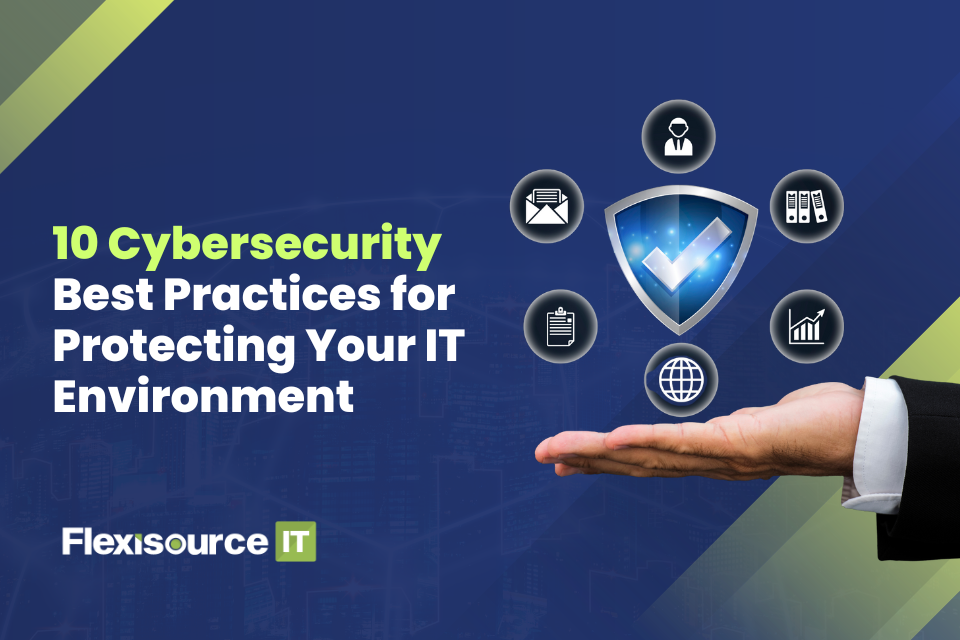In today’s interconnected world, where businesses rely heavily on digital tools and networks, the importance of cybersecurity cannot be overstated. As technology advances, so do the threats that can compromise your IT environment. From data breaches to cyberattacks, the risks are real and ever evolving. You need to implement robust cybersecurity measures to safeguard your organisation’s digital assets effectively.
This comprehensive guide will delve into ten cybersecurity best practices to fortify your IT environment and protect it from potential threats and breaches. Whether you’re an IT professional, business owner, or IT manager, these best practices are essential for ensuring the security of your organisation’s digital assets.
Table of Contents
What is the importance of cybersecurity in today’s digital landscape?
Before diving into cybersecurity best practices, let’s understand why cybersecurity is vital in the digital landscape.
In today’s digital landscape, the importance of cybersecurity cannot be overstated. With the increasing reliance on technology and the vast amount of data being generated and shared online, protecting sensitive information has become paramount.
As such, cybersecurity is crucial in a business. It safeguards our personal and financial data from unauthorised access and malicious attacks. Moreover, cybersecurity encompasses various measures and practices to prevent threats and issues in our business, such as the following:
- Protection from Cyber Threats. With the increasing reliance on digital technologies, the number and sophistication of cyber threats have also escalated. Cybercriminals continuously seek vulnerabilities to exploit, making it crucial to stay one step ahead in safeguarding your IT environment.
- Data Protection. Your organisation’s data is a valuable asset. Whether it’s sensitive customer information or proprietary business data, ensuring its protection is non-negotiable. Cybersecurity measures are designed to prevent unauthorised access to and data breaches.
- Reputation Management. A security breach can have severe repercussions on your organisation’s reputation. In today’s information age, news of a security breach spreads quickly. A tarnished reputation can result in financial losses and loss of trust from clients and partners.
- Legal Compliance. Many industries are subject to regulatory requirements regarding data protection. Non-compliance can lead to fines and legal consequences. Implementing cybersecurity best practices helps ensure that your organisation complies with these regulations.
- Business Continuity. Cyberattacks can disrupt your business operations, leading to downtime and financial losses. Having robust cybersecurity measures can help maintain business continuity by preventing and mitigating potential threats.
10 Cybersecurity Best Practices
Cybersecurity tips are abundant on the internet. To help you navigate this complex landscape, here are ten essential cybersecurity best practices that are the foundation for protecting your digital assets and ensuring a safer online experience.

1. Access Control
In today’s digital age, where data breaches and unauthorised access are constant concerns, implementing effective access control measures is essential for businesses of all sizes. Access control involves managing and regulating who can access specific resources, systems, or areas.
To implement these cybersecurity best practices, enact strict access control, using strong passwords and multi-factor authentication, to ensure that only authorised personnel can access sensitive information. Regularly review and update access permissions as needed.
2. Employee Training
Your employees can be your greatest asset or vulnerability in terms of cybersecurity. According to the World Economic Forum, human error accounts for 95% of cybersecurity breaches.
In this case, employee training is crucial to instil a security-conscious culture within your organisation. To implement these IT security strategies, provide ongoing training to educate your staff about the latest threats, best practices, and how to recognise and respond to potential security issues.
3. Regular Updates and Patch Management
With new threats and vulnerabilities constantly emerging, staying up to date is more important than ever. This is where regular updates play a crucial role in cybersecurity best practices, safeguarding sensitive information, and maintaining the integrity of systems.
Updates are essential for addressing security vulnerabilities in software and operating systems. As technology advances, so do cybercriminals’ techniques to exploit weaknesses in these systems. Companies can protect themselves against known vulnerabilities and prevent potential breaches by regularly updating software and applying patches.
Likewise, regularly update and patch all software and hardware in your IT environment to eliminate vulnerabilities. Automated patch management systems can streamline this process and ensure that updates are promptly applied.
4. Data Encryption
Data encryption is the process of converting data into a code to prevent unauthorised access. Implement encryption for sensitive data, both in transit and at rest. This ensures that even if data is intercepted, it remains indecipherable to unauthorised parties.
To successfully implement data encryption, there are several vital steps to follow. Firstly, it is essential to identify the specific data that requires encryption. This can include personally identifiable information (PII), financial records, intellectual property, or any other sensitive information that needs safeguarding.
Next, select an appropriate encryption algorithm and key management system. Encryption algorithms such as Advanced Encryption Standard (AES) or RSA are widely used and offer robust security measures. Likewise, implement a key management system to help generate and securely store encryption keys, essential for encrypting and decrypting the data.
Once the algorithm and key management system are chosen, it’s time to integrate them into the existing infrastructure. This involves implementing the necessary software or hardware components required for encryption processes.
After implementation, it is crucial to establish proper access controls and user authentication mechanisms. This ensures that only authorised personnel can access encrypted data using their unique credentials or digital certificates.
5. Intrusion Detection and Prevention
Intrusion detection systems (IDS) and intrusion prevention systems (IPS) are essential cybersecurity best practices for real-time monitoring of your IT environment. It involves monitoring and analysing network traffic to identify any unauthorised or malicious activities that could compromise the system.
DP systems utilise various techniques to detect and prevent intrusions, such as signature-based detection, anomaly detection, and behaviour analysis. This will alert you to potential threats, while IPS can actively block or contain them.
As such, try to deploy these systems to respond to any unusual or suspicious activity promptly.
6. Incident Response Plan
No system is entirely immune to threats.
As such, a well-defined incident response plan is crucial for Data threat prevention in the event of a security breach. A well-designed incident response plan can help organisations mitigate potential damages caused by cyberattacks. It enables them to promptly detect and respond to incidents while minimising downtime, financial losses, reputational damage, and legal consequences.
To make your IT disaster recovery plan, outline the steps to take during a security incident, including containment, eradication, and recovery. Test your plan regularly to ensure it is effective.
7. Backup and Recovery
Backup and recovery are crucial components of cybersecurity best practices. As mentioned earlier, data is the blood of any business in this digital age. However, some cyberattacks can cause data loss, interrupting operations.
Implementing backup and recovery measures is essential for several reasons. Firstly, it provides a safety net against ransomware attacks, where hackers encrypt an organisation’s data and demand a ransom for its release. With regular backups, organisations can restore their systems to a pre-attack state without paying the ransom.
Likewise, regularly backing up your data is a vital practice. Having up-to-date backups ensures that you can quickly recover your essential data. Implement a robust backup and recovery strategy to avoid data loss and downtime.
8. Network Security
Network security is critical to modern technology and IT environment protection. It focuses on protecting your organisation’s network infrastructure. It provides defence against various types of threats, such as malware, viruses, hacking attempts, unauthorised access to confidential data, and other malicious activities that can disrupt operations or compromise the privacy of individuals.
To implement robust network security, use firewalls, intrusion detection systems, and other security measures to safeguard your network from threats. Regularly monitor network traffic for suspicious activity and respond promptly.
9. Security Audits and Compliance
A security audit systematically evaluates an organisation’s information systems to identify potential vulnerabilities and assess its overall security posture. It comprehensively examines the organisation’s IT infrastructure, policies, procedures, and practices.
On the other hand, compliance refers to the adherence to specific laws, regulations, or standards related to data protection and cybersecurity. Organisations must comply with various regulations, such as the General Data Protection Regulation (GDPR) and Payment Card Industry Data Security Standard (PCI DSS).
Security audits and compliance go hand in hand with cybersecurity best practices as they help organisations identify risks associated with data breaches or unauthorised access to sensitive information. Organisations can proactively mitigate potential risks by conducting regular security audits and maintaining compliance with relevant regulations.
10. User Awareness
User awareness is the final piece of the cybersecurity puzzle. It refers to users’ consciousness of potential risks and awareness of common online threats, recognising warning signs of malicious activities, and taking necessary precautions to safeguard sensitive data.
Likewise, always educate your users about the importance of cybersecurity and encourage responsible online behaviour. This includes recognising phishing attempts and avoiding risky online activities.
Conclusions
In conclusion, implementing robust cybersecurity practices is not just necessary; it’s an ongoing commitment to safeguarding your digital assets’ integrity, confidentiality, and availability. To protect your business effectively, take action today. Implement these cybersecurity best practices and consider seeking the expertise of cybersecurity professionals like Flexisource IT!
Protect your business today! Let Flexisource IT handle your IT infrastructure. Contact us to learn more!
Pamela is a full-time content writer and a lifelong Philomath. Her previous experience as a research analyst made her passionate about traveling the world and understanding how it works. During her day off, you can often find her indoors, writing stories or oil painting.


